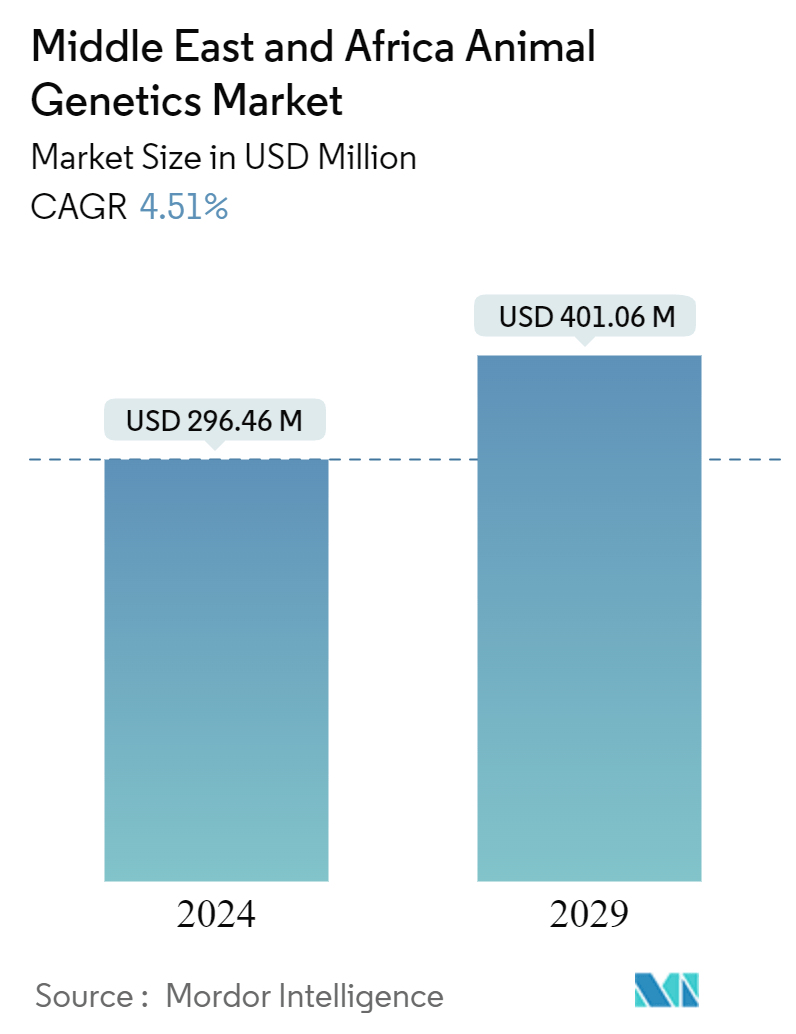Market Size of Middle East And Africa Animal Genetics Industry

| Study Period | 2019 - 2029 |
| Base Year For Estimation | 2023 |
| Market Size (2024) | USD 296.46 Million |
| Market Size (2029) | USD 401.06 Million |
| CAGR (2024 - 2029) | 4.51 % |
| Market Concentration | Medium |
Major Players
*Disclaimer: Major Players sorted in no particular order |
Middle East And Africa Animal Genetics Market Analysis
The Middle East And Africa Animal Genetics Market size is estimated at USD 296.46 million in 2024, and is expected to reach USD 401.06 million by 2029, growing at a CAGR of 4.51% during the forecast period (2024-2029).
The major factors driving the market growth include an high prevalence of avian influenza outbreaks, increasing consumer demand for animal-derived protein, and increased adoption of advanced genetic technologies for large-scale production and quality breeds.
The high prevalence of avian influenza outbreaks in South Africa is expected to boost the demand for animal genetics, thereby boosting the market growth over the forecast period. For instance, in May 2023, the Western Cape Veterinary Services warned poultry farmers that avian influenza had been detected in two commercial layer farms in the Paardeberg area (in the Drakenstein and Swartland Local Municipalities), and approximately 120,000 birds were affected by the disease. Similarly, according to the World Organization for Animal Health (WOAH), in June 2023, in mid-June, avian influenza outbreaks occurred among more than 215,000 poultry in Gauteng and then in a flock of 180,000 birds in Mpumalanga. Therefore, the rising occurrences of avian influenza outbreaks will likely encourage poultry farmers in the MEA region to seek disease-resistant poultry genetics testing, thereby driving the market growth.
The rising adoption of various genetic improvement strategies in developing countries like Egypt is projected to drive the growth of the animal genetics market in the region during the forecast period. For instance, according to the article published by the Journal of Agriculture Science in January 2023, researchers developed a strategy for marker-assisted selection for growth in local chickens in developing countries, including Egypt. The low-cost genetic improvement strategy for local chickens in the MEA region can boost poultry productivity, food security, and economic growth, driving growth in the animal genetics market due to increased demand for genetic materials and breeding services.
Moreover, expansion initiatives by market players can enhance the availability of genetics products in the MEA region, which can make high-quality genetics more accessible to local farmers and breeders, further driving the adoption of genetics for poultry improvement. For instance, Additionally, in March 2022, Elanco Animal Health Incorporated introduced the expansion of its shared value footprint across Sub-Saharan Africa, delivering on its 2030 pledge to create sustainable development solutions for those who depend on livestock for their livelihoods.
Therefore, factors such as the increasing number of avian influenza outbreaks, rising government initiatives towards vaccination, and rising number of agreements for the development of vaccine manufacturing plants in the region are projected to enhance the Middle East and African animal genetics market growth during the forecast period. However, the shortage of skilled professionals in veterinary research may restrain the market growth during the forecast period.
Middle East And Africa Animal Genetics Industry Segmentation
As per the report's scope, animal genetics refers to the branch of genetics that focuses on the study of the genetic makeup, inheritance patterns, and variation within animal species. It encompasses the genetic traits, characteristics, and hereditary information carried by animals, which are passed from one generation to the next through reproduction. The Middle East and Africa Animal Genetics Market is segmented by animal, animal genetic testing services and geography. By animal, the market is segmented into poultry, porcine, canine, and other animals. By animal genetic testing services, the market is segmented into DNA typing, genetic trait tests, and other animal genetic testing services. By geography, the market is segmented into GCC, South Africa, and Rest of Middle East and Africa. For each segment, the market size is provided in terms of USD value.
| By Animals | |
| Poultry | |
| Porcine | |
| Canine | |
| Other Animals |
| By Animal Genetic Testing Services | |
| DNA Typing | |
| Genetic Trait Tests | |
| Other Animal Genetic Testing Services |
| By Geography | |
| GCC | |
| South Africa | |
| Rest of Middle East and Africa |
Middle East And Africa Animal Genetics Market Size Summary
The Middle East and Africa Animal Genetics Market is poised for growth, driven by several key factors. The high prevalence of avian influenza outbreaks, particularly in South Africa, is expected to significantly boost the demand for animal genetics, as poultry farmers seek disease-resistant genetic solutions. Additionally, the increasing consumer demand for animal-derived protein and the adoption of advanced genetic technologies for large-scale production and quality breeds are contributing to market expansion. Developing countries like Egypt are witnessing a rise in genetic improvement strategies, which are enhancing poultry productivity and food security. Market players are also expanding their presence in the region, making high-quality genetics more accessible to local farmers and breeders, further driving the adoption of genetics for poultry improvement.
The poultry segment within the animal genetics market is experiencing robust growth due to the rising prevalence of diseases such as Newcastle disease and the increasing consumption of poultry products like meat and eggs. The demand for genetics that offer traits such as rapid growth, high egg production, and disease resistance is becoming vital to meet the rising demand for poultry products. In the Gulf Cooperation Council (GCC) region, the market is expected to grow significantly due to the increasing burden of diseases in animals and the expansion of the poultry industry. Substantial investments in poultry production, particularly in Saudi Arabia, aim to achieve self-sufficiency, further driving the demand for animal genetics. The introduction of genetic testing services, such as DNA tests for Arabian horse lineages in Saudi Arabia, is also expected to boost the market by enhancing breeding quality assurance.
Middle East And Africa Animal Genetics Market Size - Table of Contents
-
1. MARKET DYNAMICS
-
1.1 Market Overview
-
1.2 Market Drivers
-
1.2.1 Increasing Consumer Demand for Animal-derived Protein
-
1.2.2 Increased Adoption of Advanced Genetic Technologies for Large-scale Production and Quality Breeds
-
-
1.3 Market Restraints
-
1.3.1 Shortage of Skilled Professionals in Veterinary Research
-
-
1.4 Porter's Five Forces Analysis
-
1.4.1 Threat of New Entrants
-
1.4.2 Bargaining Power of Buyers/Consumers
-
1.4.3 Bargaining Power of Suppliers
-
1.4.4 Threat of Substitute Products
-
1.4.5 Intensity of Competitive Rivalry
-
-
-
2. MARKET SEGMENTATION (Market Size by Value-USD)
-
2.1 By Animals
-
2.1.1 Poultry
-
2.1.2 Porcine
-
2.1.3 Canine
-
2.1.4 Other Animals
-
-
2.2 By Animal Genetic Testing Services
-
2.2.1 DNA Typing
-
2.2.2 Genetic Trait Tests
-
2.2.3 Other Animal Genetic Testing Services
-
-
2.3 By Geography
-
2.3.1 GCC
-
2.3.2 South Africa
-
2.3.3 Rest of Middle East and Africa
-
-
Middle East And Africa Animal Genetics Market Size FAQs
How big is the Middle East And Africa Animal Genetics Market?
The Middle East And Africa Animal Genetics Market size is expected to reach USD 296.46 million in 2024 and grow at a CAGR of 4.51% to reach USD 401.06 million by 2029.
What is the current Middle East And Africa Animal Genetics Market size?
In 2024, the Middle East And Africa Animal Genetics Market size is expected to reach USD 296.46 million.

